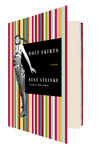
Baroness Elsa von Freytag-Loringhoven was born in Swinemunde, Germany, in 1874. At the age of nineteen she moved to Berlin to find work as an actress, followed one husband of three to the Amalfi Coast and eventually to New York, wrote poetry that defied classification (Futurist? Cubist?), and emigrated to the United States, where she developed the role of her lifetime at the center of the emerging Dada movement in Greenwich Village. As a woman ahead of her time, whose very dress was considered performance art, she became both model and muse for avant-garde elites like Marcel Duchamp and renowned photographer Man Ray. In Holy Skirts, however, René Steinke refuses the strictures of the purely historical, bypassing a biographical treatment of the Baroness in favour of a more fluid fictional “truth.”
Fortunately, and perhaps in spite of these generic challenges, where Holy Skirts succeeds most brilliantly (and most truthfully) is in its evocation of the evolution of an artistic self. Elsa’s journey is so clearly rooted in her “wanting to pay closer attention”; her career aspirations and love affairs so completely wedded to her notions of intellect—“a spiritual property, an instinct developed until it comes to one’s consciousness”—that her story, in Steinke’s able hands, becomes less linear than concentric. Although time marches forward, Elsa’s consciousness as a woman and artist ripples and rages towards her very core. In the course of the novel, she becomes more real to both herself and the reader, which makes for the best kind of character-driven page-turner.
In Berlin, Elsa finds work as a nude “statue” in a burlesque. It is here, at the Wintergarten Theatre, that she first learns to perform and posture for men, a skill that serves her well throughout her life, a means not only to sexual awakening, but also to a more traditional education. When she is introduced, through her lover Mello’s bookshelves, to Flaubert, von Eichendorff, Shaw, and Rilke, she discovers a new obsession, and finds “her brain growing in circumference and intricacy, one long ribbon reaching down her throat for her heart.” Eventually, her hunger for knowledge and unfettered personal expression butt up against society’s narrow notions of womanhood. She begins to practice a kind of vigilant exhibitionism, finding outlets in a wild fashion sense (a taillight as bustle, a coal scuttle as hat), poetry as both image and protest, and libertine sexual manners.
But if Elsa herself is prone to flamboyance, Steinke’s prose offers controlled bursts of odd and elegant lyricism—“the folds in his cheeks made his face look like a pinched heart”—perhaps more akin to the baroness’s poems than her actual persona. She writes with clean eloquence of Elsa’s sexual and psychological frustrations and fulfillments, but never shies away from some of her protagonist’s more sordid moments. The evenly calibrated narrative voice here seems equally at ease telescoping out to describe particular scenes of early New York bohemia as it is outlining some of the outrageous artistic and philosophical designs that define Elsa’s compelling and tumultuous inner life.
In the end, what endures of Steinke’s subtly drawn baroness is her passionate insistence on the organic nature of love/lust, of the mind/soul, of art itself. Even the syphilis-induced hallucinations that plague Elsa before her death seem less madness than revelation: a heightened—and ultimately creative—form of seeing and being.





